何时用不定式何时用分词与动名词
- 格式:doc
- 大小:59.50 KB
- 文档页数:16
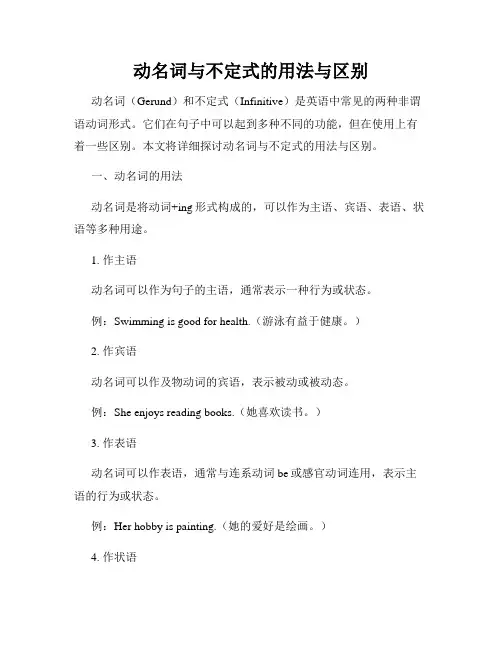
动名词与不定式的用法与区别动名词(Gerund)和不定式(Infinitive)是英语中常见的两种非谓语动词形式。
它们在句子中可以起到多种不同的功能,但在使用上有着一些区别。
本文将详细探讨动名词与不定式的用法与区别。
一、动名词的用法动名词是将动词+ing形式构成的,可以作为主语、宾语、表语、状语等多种用途。
1. 作主语动名词可以作为句子的主语,通常表示一种行为或状态。
例:Swimming is good for health.(游泳有益于健康。
)2. 作宾语动名词可以作及物动词的宾语,表示被动或被动态。
例:She enjoys reading books.(她喜欢读书。
)3. 作表语动名词可以作表语,通常与连系动词be或感官动词连用,表示主语的行为或状态。
例:Her hobby is painting.(她的爱好是绘画。
)4. 作状语动名词可以作状语,表示行为发生的时间、原因、结果等。
例:He made money by selling paintings.(他通过卖画赚钱。
)二、不定式的用法不定式是动词原形,通常由to + 动词构成,可以用作名词、形容词或副词。
1. 作名词不定式可以作名词,作主语、表语、宾语等。
例:To learn a foreign language is important.(学一门外语很重要。
)2. 作形容词不定式可以作形容词,修饰名词或代词。
例:She has a lot of work to do.(她有很多工作要做。
)3. 作副词不定式可以作副词,修饰动词、形容词或副词。
例:He worked hard to pass the exam.(他努力学习以通过考试。
)三、动名词与不定式的区别虽然动名词和不定式都是非谓语动词形式,但它们在使用上有一些区别。
1. 主动与被动动名词通常表示主动意义,而不定式可以表示被动意义。
例:I enjoy swimming.(我喜欢游泳。

不定式作定语的用法不定式及其短语作定语,与其他短语作定语一样,一般都放在被修饰的词之后,通常表示一个将来的动作,有时也可以表示某一过去的特定动作。
一些名词后常用不定式作定语,如:chance(机会),way(方法),time(时间)等;另外,the first,the second,the last,the only等作名词或者它们作形容词用来修饰代词,它们或它们所修饰的代词后,也常用不定式作定语。
不定式作定语时,不定式与被修饰词之间存在的关系复杂,有的是主谓关系;有的是动宾关系;有的是动状关系,还有的不存在主谓、动宾、动状关系。
1、主谓关系的(1)We must find a person to do the work.(2) There is no one to take care of her.(3) In my family,my mother is always the first one to get up.(4) He is always the first to come and the last to leave.(5) We need someone to go and get a doctor.2、动宾关系的如果不定式与被修饰的词在逻辑上存在动宾关系,不定式里的动词必须是及物动词。
注意:是及物动词的,后面不要再加宾语,因为前面的被修饰词是它的宾语;是不及物动词的,要加上适当的介词或副词让它变成及物动词,只有这样,它才能带上前面的宾语。
(1)He has a lot of books to read.(2) I would like a magazine to look at.(3) Here is some advice for you to follow.(4) Do you have anything else to say?(5) There is no one to take care of.(6) She has nothing to worry about.3、动状关系的被修饰词如果是不定式里动词的状语,应多用介词短语。
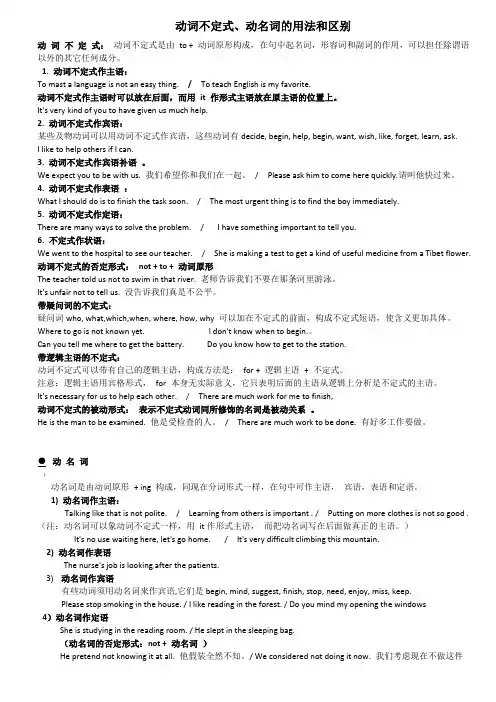
动词不定式、动名词的用法和区别动词不定式:动词不定式是由to + 动词原形构成,在句中起名词,形容词和副词的作用,可以担任除谓语以外的其它任何成分。
1. 动词不定式作主语:To mast a language is not an easy thing. / To teach English is my favorite.动词不定式作主语时可以放在后面,而用it 作形式主语放在原主语的位置上。
It's very kind of you to have given us much help.2. 动词不定式作宾语:某些及物动词可以用动词不定式作宾语,这些动词有decide, begin, help, begin, want, wish, like, forget, learn, ask.I like to help others if I can.3. 动词不定式作宾语补语。
We expect you to be with us. 我们希望你和我们在一起。
/ Please ask him to come here quickly.请叫他快过来。
4. 动词不定式作表语:What I should do is to finish the task soon. / The most urgent thing is to find the boy immediately.5. 动词不定式作定语:There are many ways to solve the problem. / I have something important to tell you.6. 不定式作状语:We went to the hospital to see our teacher. / She is making a test to get a kind of useful medicine from a Tibet flower.动词不定式的否定形式:not + to + 动词原形The teacher told us not to swim in that river. 老师告诉我们不要在那条河里游泳。
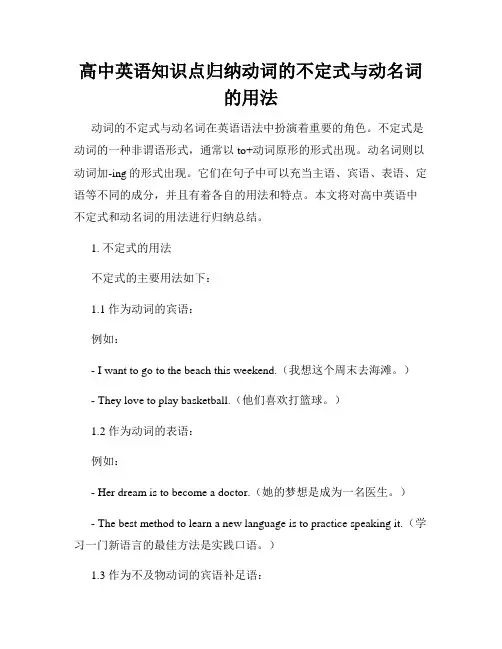
高中英语知识点归纳动词的不定式与动名词的用法动词的不定式与动名词在英语语法中扮演着重要的角色。
不定式是动词的一种非谓语形式,通常以to+动词原形的形式出现。
动名词则以动词加-ing的形式出现。
它们在句子中可以充当主语、宾语、表语、定语等不同的成分,并且有着各自的用法和特点。
本文将对高中英语中不定式和动名词的用法进行归纳总结。
1. 不定式的用法不定式的主要用法如下:1.1 作为动词的宾语:例如:- I want to go to the beach this weekend.(我想这个周末去海滩。
)- They love to play basketball.(他们喜欢打篮球。
)1.2 作为动词的表语:例如:- Her dream is to become a doctor.(她的梦想是成为一名医生。
)- The best method to learn a new language is to practice speaking it.(学习一门新语言的最佳方法是实践口语。
)1.3 作为不及物动词的宾语补足语:例如:- They made him leave the party.(他们让他离开派对。
)- She saw the cat climb up the tree.(她看到猫爬上树。
)1.4 作为介词的宾语:例如:- He is good at playing the piano.(他擅长弹钢琴。
)- We are interested in learning new things.(我们对学习新事物感兴趣。
)1.5 作为名词的定语:例如:- We need a pen to write the letter.(我们需要一支笔来写信。
)- Is there anything to eat in the fridge?(冰箱里有吃的东西吗?)2. 动名词的用法动名词的主要用法如下:2.1 作为名词的主语:例如:- Swimming is my favorite sport.(游泳是我最喜欢的运动。
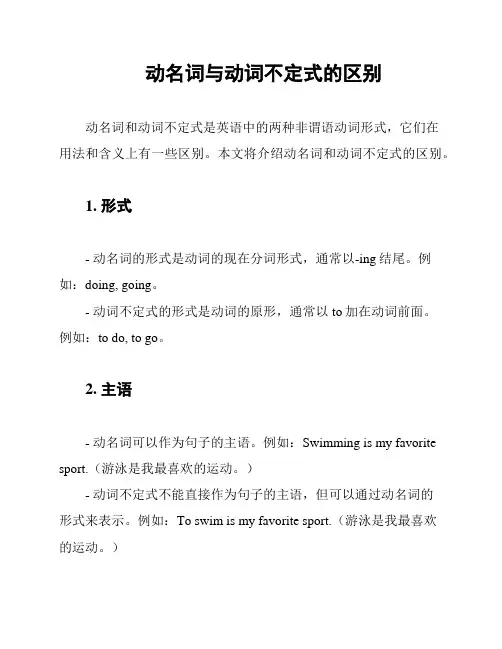
动名词与动词不定式的区别动名词和动词不定式是英语中的两种非谓语动词形式,它们在用法和含义上有一些区别。
本文将介绍动名词和动词不定式的区别。
1. 形式- 动名词的形式是动词的现在分词形式,通常以-ing结尾。
例如:doing, going。
- 动词不定式的形式是动词的原形,通常以to加在动词前面。
例如:to do, to go。
2. 主语- 动名词可以作为句子的主语。
例如:Swimming is my favorite sport.(游泳是我最喜欢的运动。
)- 动词不定式不能直接作为句子的主语,但可以通过动名词的形式来表示。
例如:To swim is my favorite sport.(游泳是我最喜欢的运动。
)3. 动词后的宾语- 动名词可以直接跟在动词后作为宾语。
例如:I enjoy swimming.(我喜欢游泳。
)- 动词不定式通常需要用介词to来连接动词和宾语。
例如:I want to go swimming.(我想去游泳。
)4. 介词用法- 动名词可以直接跟在介词后使用。
例如:I'm interested in learning new languages.(我对研究新的语言感兴趣。
)- 动词不定式通常需要用介词to来引导介词短语。
例如:I'm looking forward to meeting you.(我期待着见到你。
)5. 用法和含义- 动名词表示一种持续性的动作或状态。
例如:He enjoys singing.(他喜欢唱歌。
)- 动词不定式表示一种将要发生的动作或状态。
例如:He wants to sing.(他想要唱歌。
)总结:动名词和动词不定式在形式、主语、宾语和介词用法上存在一些差异。
学会区分它们的用法和含义有助于提高英语表达的准确性和流利度。
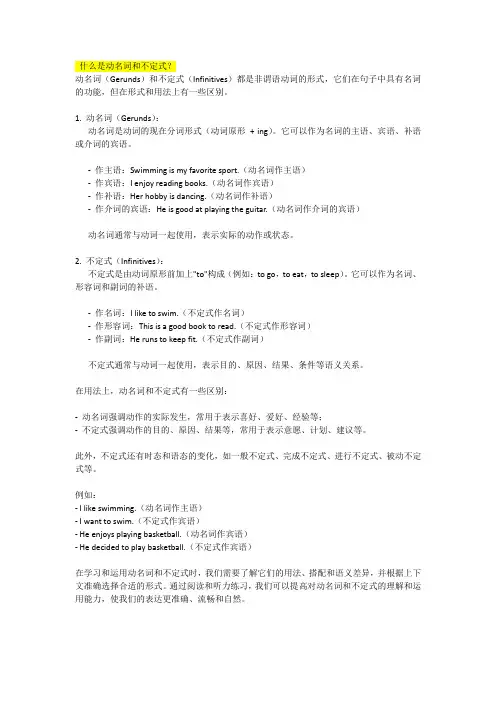
什么是动名词和不定式?动名词(Gerunds)和不定式(Infinitives)都是非谓语动词的形式,它们在句子中具有名词的功能,但在形式和用法上有一些区别。
1. 动名词(Gerunds):动名词是动词的现在分词形式(动词原形+ ing)。
它可以作为名词的主语、宾语、补语或介词的宾语。
-作主语:Swimming is my favorite sport.(动名词作主语)-作宾语:I enjoy reading books.(动名词作宾语)-作补语:Her hobby is dancing.(动名词作补语)-作介词的宾语:He is good at playing the guitar.(动名词作介词的宾语)动名词通常与动词一起使用,表示实际的动作或状态。
2. 不定式(Infinitives):不定式是由动词原形前加上"to"构成(例如:to go,to eat,to sleep)。
它可以作为名词、形容词和副词的补语。
-作名词:I like to swim.(不定式作名词)-作形容词:This is a good book to read.(不定式作形容词)-作副词:He runs to keep fit.(不定式作副词)不定式通常与动词一起使用,表示目的、原因、结果、条件等语义关系。
在用法上,动名词和不定式有一些区别:-动名词强调动作的实际发生,常用于表示喜好、爱好、经验等;-不定式强调动作的目的、原因、结果等,常用于表示意愿、计划、建议等。
此外,不定式还有时态和语态的变化,如一般不定式、完成不定式、进行不定式、被动不定式等。
例如:- I like swimming.(动名词作主语)- I want to swim.(不定式作宾语)- He enjoys playing basketball.(动名词作宾语)- He decided to play basketball.(不定式作宾语)在学习和运用动名词和不定式时,我们需要了解它们的用法、搭配和语义差异,并根据上下文准确选择合适的形式。
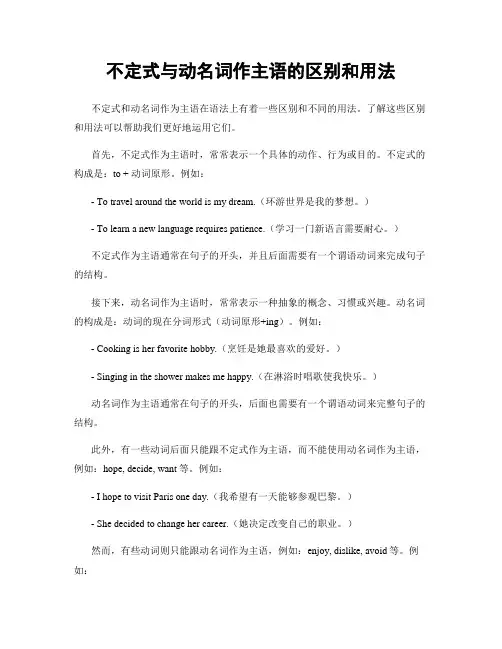
不定式与动名词作主语的区别和用法不定式和动名词作为主语在语法上有着一些区别和不同的用法。
了解这些区别和用法可以帮助我们更好地运用它们。
首先,不定式作为主语时,常常表示一个具体的动作、行为或目的。
不定式的构成是:to + 动词原形。
例如:- To travel around the world is my dream.(环游世界是我的梦想。
)- To learn a new language requires patience.(学习一门新语言需要耐心。
)不定式作为主语通常在句子的开头,并且后面需要有一个谓语动词来完成句子的结构。
接下来,动名词作为主语时,常常表示一种抽象的概念、习惯或兴趣。
动名词的构成是:动词的现在分词形式(动词原形+ing)。
例如:- Cooking is her favorite hobby.(烹饪是她最喜欢的爱好。
)- Singing in the shower makes me happy.(在淋浴时唱歌使我快乐。
)动名词作为主语通常在句子的开头,后面也需要有一个谓语动词来完整句子的结构。
此外,有一些动词后面只能跟不定式作为主语,而不能使用动名词作为主语,例如:hope, decide, want等。
例如:- I hope to visit Paris one day.(我希望有一天能够参观巴黎。
)- She decided to change her career.(她决定改变自己的职业。
)然而,有些动词则只能跟动名词作为主语,例如:enjoy, dislike, avoid等。
例如:- I enjoy swimming in the ocean.(我喜欢在海洋中游泳。
)- He dislikes cleaning the house.(他不喜欢打扫房子。
)总结一下,不定式和动名词作为主语的区别和用法在于:不定式更常表示具体的动作或目的,动名词更常表示抽象的概念或习惯;有些动词只能跟不定式作为主语,而有些动词只能跟动名词作为主语。

英语中动名词是什么动词有四种变化形态,分别是:不定式(to do)、动名词(V-ing)、现在分词(V-ing)和过去分词(V-ed)。
再次强调以下至关重要的概念:不定式是助动词的变化,带有不确定的语气;动名词是动词的名词化,可以用在主语及宾语等位置;而分词则是形容词化,可以当形容词用。
动名词是具有名词性质的动词形式,是一种非谓语动词,这种形式兼有动词性质和名词性质,在句子中可以做主语、宾语、表语、定语等成分,几乎名词能做的成分动名词都能作,所以动名词可以说是更倾向于名词,因此叫动名词。
(归根结底动名词的词性是名词。
)一、动名词作主语。
1、直接位于句首,如:Swimming is a good sport in summer.在夏天,游泳是一项好的消遣。
2、用it 作形式主语,把动名词(真实主语)置于句尾作后置主语。
,如:It is no use telling him not to worry.告诉他不要担心是没有用的。
(这个句型中真正主语只能是v-ing形式)注意:important,essential,necessary 等形容词不能用于上述结构。
3. 用于“There be”结构中,如:There is no saying when he'll come.很难说他何时回来。
(There is + no + doing something 是英语中的固定搭配,表示“说不上du;很难说”。
)4. 动名词的复合结构作主语:当动名词有自己的逻辑主语时,常可以在前面加上一个名词或代词的所有格,构成动名词的复合结构, 动名词疑问句通常使用这种结构做主语Their coming to help was a great encouragement to us.他们来支援我们是很大的鼓舞。
Does your saying that mean anything to him?你的话对他有什么意义吗?二、动名词作宾语1. 作动词的宾语某些动词后出现非限定性动词时只能用动名词作宾语,不能用不定式。
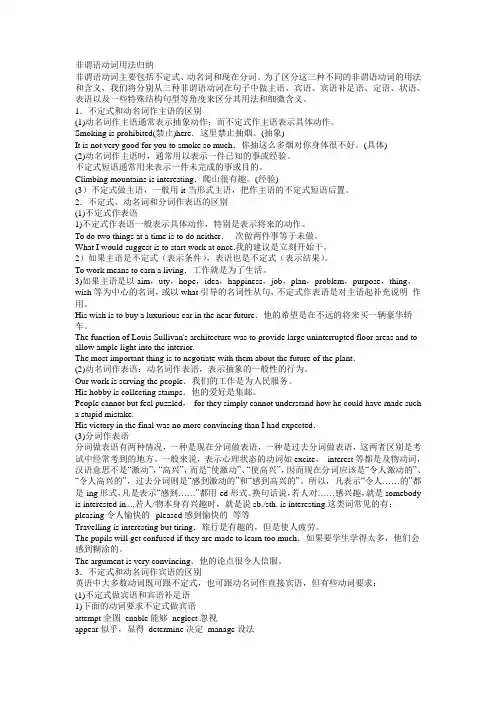
非谓语动词用法归纳非谓语动词主要包括不定式、动名词和现在分词。
为了区分这三种不同的非谓语动词的用法和含义,我们将分别从三种非谓语动词在句子中做主语、宾语、宾语补足语、定语、状语、表语以及一些特殊结构句型等角度来区分其用法和细微含义。
1.不定式和动名词作主语的区别(1)动名词作主语通常表示抽象动作;而不定式作主语表示具体动作。
Smoking is prohibited(禁止)here.这里禁止抽烟。
(抽象)It is not very good for you to smoke so much.你抽这么多烟对你身体很不好。
(具体)(2)动名词作主语时,通常用以表示一件已知的事或经验。
不定式短语通常用来表示一件未完成的事或目的。
Climbing mountains is interesting.爬山很有趣。
(经验)(3)不定式做主语,一般用it当形式主语,把作主语的不定式短语后置。
2.不定式、动名词和分词作表语的区别(1)不定式作表语1)不定式作表语一般表示具体动作,特别是表示将来的动作。
To do two things at a time is to do neither.--次做两件事等于未做。
What I would suggest is to start work at once.我的建议是立刻开始干。
2)如果主语是不定式(表示条件),表语也是不定式(表示结果)。
To work means to earn a living.工作就是为了生活。
3)如果主语是以aim,uty,hope,idea,happiness,job,plan,problem,purpose,thing,wish等为中心的名词,或以what引导的名词性从句,不定式作表语是对主语起补充说明作用。
His wish is to buy a luxurious car in the near future.他的希望是在不远的将来买一辆豪华轿车。
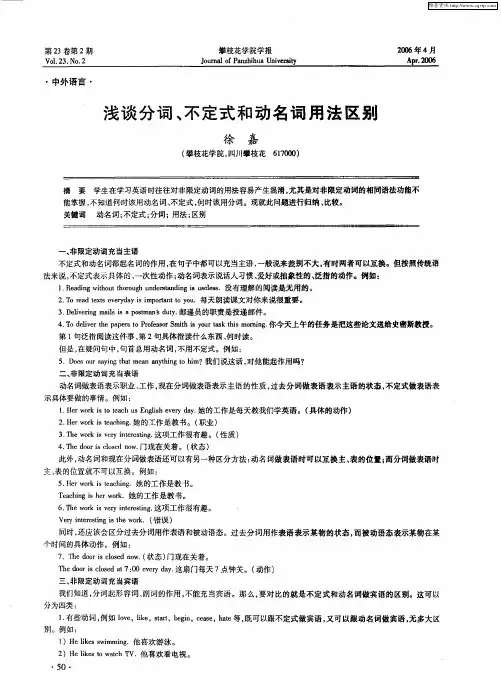
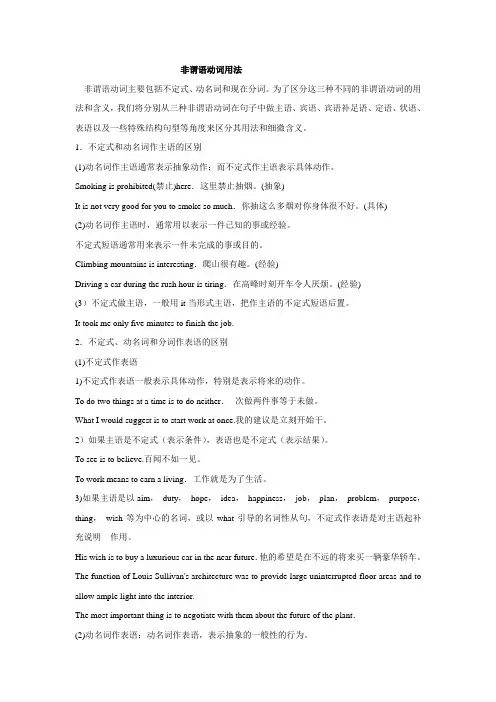
非谓语动词用法非谓语动词主要包括不定式、动名词和现在分词。
为了区分这三种不同的非谓语动词的用法和含义,我们将分别从三种非谓语动词在句子中做主语、宾语、宾语补足语、定语、状语、表语以及一些特殊结构句型等角度来区分其用法和细微含义。
1.不定式和动名词作主语的区别(1)动名词作主语通常表示抽象动作;而不定式作主语表示具体动作。
Smoking is prohibited(禁止)here.这里禁止抽烟。
(抽象)It is not very good for you to smoke so much.你抽这么多烟对你身体很不好。
(具体)(2)动名词作主语时,通常用以表示一件已知的事或经验。
不定式短语通常用来表示一件未完成的事或目的。
Climbing mountains is interesting.爬山很有趣。
(经验)Driving a car during the rush hour is tiring.在高峰时刻开车令人厌烦。
(经验)(3)不定式做主语,一般用it当形式主语,把作主语的不定式短语后置。
It took me only five minutes to finish the job.2.不定式、动名词和分词作表语的区别(1)不定式作表语1)不定式作表语一般表示具体动作,特别是表示将来的动作。
To do two things at a time is to do neither.--次做两件事等于未做。
What I would suggest is to start work at once.我的建议是立刻开始干。
2)如果主语是不定式(表示条件),表语也是不定式(表示结果)。
To see is to believe.百闻不如一见。
To work means to earn a living.工作就是为了生活。
3)如果主语是以aim,duty,hope,idea,happiness,job,plan,problem,purpose,thing,wish等为中心的名词,或以what引导的名词性从句,不定式作表语是对主语起补充说明作用。
初中英语知识归纳动词的不定式和动名词动词的不定式和动名词是英语语法中的两个重要概念。
它们在句子中可以充当主语、宾语、表语、定语等成分,具有多种用法和结构。
本文将系统归纳动词的不定式和动名词的基本用法,并探讨它们在句子中的常见应用。
一、不定式的基本结构不定式是动词的一种形式,包括to + 动词原形,如to eat, to sleep等。
不定式具有以下基本结构:1. 动词不定式作主语:- To learn English is important.- Swimming is my favorite sport.2. 动词不定式作宾语:- I want to visit Paris.- She loves to read books.3. 动词不定式作表语:- My dream is to become a doctor.- The most important thing is to be yourself.4. 动词不定式作定语:- I have a book to read.- We need a place to live.二、动词不定式的常见用法1. 表示目的和意图:- I study hard to pass the exam.- He exercises regularly to stay healthy.2. 接在情态动词后,表示推测、推理:- He must be asleep.- They may have left already.3. 与一些动词连用,构成特定短语或习惯搭配:- Try to do something.- Want to do something.- Need to do something.4. 与某些动词连用,构成复合宾语:- I saw him leave the room.- She heard the baby cry.三、动名词的基本结构动名词是动词的一种形式,在句中作名词用。
动名词与不定式的区别与运用在英语语法中,动名词(gerund)和不定式(infinitive)是两种常见的名词形式,它们在使用和意义上有一些区别。
本文将详细介绍动名词和不定式的特点、用法和运用场景。
一、动名词的特点与用法1. 动名词的构成:动名词由动词+ing构成,具有名词的性质。
2. 作主语:动名词可作为句子的主语,在句中表示一种行为或状态。
例:Swimming is a good exercise.(游泳是一项好的运动。
)3. 作宾语:动名词可作及物动词的宾语,表示动作的承受者。
例:I enjoy dancing on weekends.(我喜欢周末跳舞。
)4. 作介词宾语:动名词常常作为介词的宾语,表示介词所指的动作或状态。
例:She is thinking about buying a new car.(她正在考虑买辆新车。
)5. 作某些特定动词的宾语:某些动词后只能接动名词作宾语。
例如:admit, avoid, consider, recommend, discuss等。
例:He suggested going to the cinema.(他建议去看电影。
)二、不定式的特点与用法1. 不定式的构成:不定式由to + 动词原形构成,具有名词、形容词或副词的性质。
2. 作主语:不定式可作为句子的主语,常用于表示抽象的概念、信念或理想。
例:To learn a foreign language requires patience and perseverance.(学习一门外语需要耐心和毅力。
)3. 作宾语:不定式可作及物动词的宾语,常与动词一起构成某些固定搭配。
例:She promised to help me with my homework.(她答应帮我做作业。
)4. 作目的状语:不定式可表示动作、状态的目的或用途。
例:I went to the store to buy some groceries.(我去商店买些杂货。
......word...专业技术行业资料...... ......范文范例学习参考指导....... 何时用不定式何时用分词与动名词
Ⅰ.动名词和不定式做主语的相同点 1.不定式短语和动名词做主语时,常常为了保持句子的平衡,用it来做形式主语,如: It is not easy to learn English well. It is no use asking him for help. 2.如果主语用了不定式,表语和宾语也要用不定式;主语用了动名词,表语和宾语也要用动名词,这在英语中称为对称性,如: To see is to believe. = Seeing is believing. (眼见为实) (85)It is better to stay home than _A__ out. A. to go B. going C. go D. gone Ⅱ.动名词和不定式做主语的不同点 1.不定式做主语常表示具体的某一动作;表示泛指或一般的抽象的概念时,多用动名词,如: (92)_B_ is a good form of exercise for both young and old. ......word...专业技术行业资料...... ......范文范例学习参考指导....... A. The walk B. Walking C. To walk D. Walk
2.在”There/It +be+ no use(good/help/need)”之后常用动名词做主语,而少用不定式,如: It /There is no use crying over the split milk. It /There is no help taking this medicine. ★但是如果该句型中用了for引出不定式的逻辑主语,就只能用不定式,如: (93) There is no good for us to do that exercise. 3.不定式可以和when, where, how, what, whether等连用,在句子中做主语,宾语和表语,而动名词则不能,如: How to solve the problem is a hot potato. Where to put the box seems hard to decide. Whether to do it hasn’t been decided. What to do next is up to you.
时态、语态及其基本用法 A. 不定式 1.不定式的时态、语态有三种形式:①一般式,如,to write / to be written ;②进行式,如,to be writing / to have been writing;③完成式,如,to have written / to have been written 。 2.基本用法 ①不定式的一般式,表示的动作与谓语动词表示的动作同时发生,有时也发生在谓语动词表示的动作之后。如: He seems to know this.(=It seems that he knows this.) ......word...专业技术行业资料...... ......范文范例学习参考指导....... I hope to see you again.(=I hope that I’ll see you again.)
He doesn’t like to be laughed at. (=He doesn’t like that he is being laughed at.) ②不定式的进行式,表示不定式的动作正在进行,与谓语动词表示的动作同时发生。如: When the mother went into the room, the boy pretended to be sleeping. (=… , the boy pretended that he was sleeping .) I heard the English song being sung by him. (=I heard that the English song was being sung by him.) ③.不定式的完成式,表示的动作发生在谓语动词表示的动作之前。如: I am sorry to have kept you waiting so long. (= I am sorry that I kept you waiting so long. ) Having been well written, the book was translated into many languages. (=Because it had been well written, …) B. 分词 1.只有现在分词才有时态和语态形式的变化。现在分词的时态、语态有两种形式:①一般式,如,doing / being done; ②完成式,如,having done / having been done 。 2.基本用法 ①现在分词的一般式,表示的动作与谓语动词表示的动作同时发生,或在谓语动词表示的动作之前发生。如: The boys and girls went to school, singing and dancing all along the way . They all jumped with joy ,hearing the good news. The girl could not help crying ,being criticized in the public. ......word...专业技术行业资料...... ......范文范例学习参考指导....... ②现在分词的完成式,表示的动作在谓语动词表示的动作之前已发生,常用作时
间状语或原因状语。如: Having done the work very well ,he was praised by the teacher. Having been shot by a bullet, the man fell down dead. C. 动名词 1.动名词的时态、语态有两种形式:①一般式,如,writing / being written ; ②完成式,如,having written / having been written 。 2.基本用法 ①动名词的一般式不表示动作正在进行,但作具有状语性质的宾语时,动名词一般式表示的动作与谓语动词的动作同时发生。如: The teacher is busy collecting the students’ exam papers. ②动名词的完成式在作具有状语性质的宾语时,表示的动作在谓语动词的动作之前已发生。如: He was praised by the teacher for having done the work wonderfully. He felt so sorry for not having been given the chance to work in the company. 三、不定式、分词、动名词的词性特征和句法功能 1.不定式既有动词的一些特征,又具有名词、形容词、和副词的句法功能,因此,不定式在句中作:主语、表语、宾语、宾语补足语、定语、状语、独立成分。 2.分词即具有动词的一些特征,又具有形容词和副词的句法功能,因此,不定式在句中作:表语、宾语补足语、定语、状语、独立成分。 3.动名词,顾名思义,既有动词的一些特征,又具有名词的句法功能,因此,动名词在句中作:主语、表语、宾语、定语、同位语。 四、不定式、分词、动名词句法功能用法的比较 ......word...专业技术行业资料...... ......范文范例学习参考指导....... 1. 从上面不定式、分词、动名词的词性特征和句法功能中,我们不难看出它们
在句子中的作用既有较多的共性,又有稍微的差异: a.相同的句法功能:①不定式、分词都能作:表语、定语 、宾语补足语、状语、独立成分;②不定式、动名词都能作:主语、表语、宾语 ;③不定式、分词、动名词都能作:表语、定语。 b.不同的句法功能:不定式可作:同位语。如: That was her desire, to go to America for further study after finishing middle school. 2.正确运用好不定式、分词、动名词 ⑴.不定式、分词、动名词作表语时的比较。请看例句: ①My job is to teach the students English. ②My job is teaching the students English. ③My job is interesting. ④I am interested in English. 辨析:A. ①不定式与动名词作表语一般可以互换使用,在意义上没有多大差别,且其形式差异较大,很容易把握, 如上面例句的①②;②现在分词和动名词同形,在作表语时,学生不易识别。分辨方法有三:a)分词作表语说明主语的性质特征,回答how的问题;不定式和动名词作表语则说明主语的内容,回答what 或 doing what 问题, 如: My job is interesting.(=How is my job?) ; My job is teaching ( to teach ) the students English. (=What is my job?); b)动名词具有名词的句法功能,也能做主语,我们不妨把句中的表语转换成主语,如果句子成立,则是动名词作表语,否则是现在分词作表语。如:My job is teaching the students English→Teaching the students English is my job.显然句子是成立的,原句中的